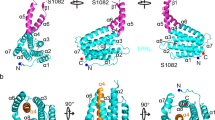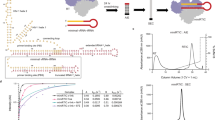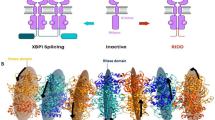Abstract
The solution structure of the N-terminal zinc binding domain (residues 1–55; IN1–55) of HIV-1 integrase has been solved by NMR spectroscopy. IN1–55 is dimeric, and each monomer comprises four helices with the zinc tetrahedrally coordinated to His 12, His 16, Cys 40 and Cys 43. IN1–55 exists in two interconverting conformational states that differ with regard to the coordination of the two histidine side chains to zinc. The different histidine arrangements are associated with large conformational differences in the polypeptide backbone (residues 9–18) around the coordinating histidines. The dimer interface is predominantly hydrophobic and is formed by the packing of the N-terminal end of helix 1, and helices 3 and 4. The monomer fold is remarkably similar to that of a number of helical DMA binding proteins containing a helix-turn-helix (HTH) motif with helices 2 and 3 of IN1–55 corresponding to the HTH motif. In contrast to the DNA binding proteins where the second helix of the HTH motif is employed for DNA recognition, IN1–55 uses this helix for dimerization.
This is a preview of subscription content, access via your institution
Access options
Subscribe to this journal
Receive 12 print issues and online access
$189.00 per year
only $15.75 per issue
Buy this article
- Purchase on Springer Link
- Instant access to full article PDF
Prices may be subject to local taxes which are calculated during checkout
Similar content being viewed by others
References
Whitcomb, J.M. & Hughes, S.H. Retroviral reverse transcription and integration: progress and problems. Annu. Rev. Cell Biol. 8, 275–306 (1992).
Goff, S.P. Genetics of retroviral integration. Annu. Rev. Genet. 26, 527–544 (1992).
Vink, C. & Plasterk, R.H.A. The human immunodeficiency virus integrase protein. Trends. Genet. 9, 433–438 (1993).
Katz, R.A. & Skalka, A.M. The retroviral enzymes. Annu. Rev. Biochem. 63, 133–173 (1994).
Engelman, A., Mizuuchi, K. & Craigie, R. HIV-1 DNA integration: mechanism of viral DNA cleavage and DNA strand transfer. Cell 67, 1211–1221 (1991).
Bushman, F.D., Engelman, A., Palmer, I., Wingfield, P.T. & Craigie, R. Domains of integrase protein of human immunodeficiency virus type-1 responsible for polynucleotidyl transfer and zinc binding. Proc. Natl. Acad. Sci. USA 90, 3428–3432 (1993).
Chow, S.A., Vincent, K.A., Ellison, V. & Brown, P.O. Reversal of integration and DNA splicing mediated by integrase of human immunodeficiency virus. Science 255, 723–726 (1992).
Vink, C., Oude Groeneger, A.M. & Plasterk, R.H.A. Identification of the catalytic and DNA-binding region of the human immunodeficiency virus type I integrase protein. Nucleic Acids Res. 21, 1419–1425 (1993).
Engelman, A., Hickman, A.B. & Craigie, R. The core and carboxyl-terminal domains of the integrase protein of human immunodeficiency virus type 1 each contribute to nonspecific DNA binding. J. Virol. 68, 5911–5917 (1994).
Woerner, A.M. & Marcus-Sekura, C.J. Characterization of a DNA binding domain in the C-terminus of HIV-1 integrase by deletion mutagenesis. Nucleic Acids Res. 21, 3507–3511 (1993).
Dyda, F., Hickman, A.B., Jenkins T.M., Engelman, A., Craigie, R. & Davies, D.R. Crystal structure of the catalytic domain of HIV-1 integrase: similarity to other polynucleotidyl transf erases. Science 266, 1981–1986 (1994).
Bujacz, G., Jaskolski, M., Alexandratos, J., Wlodawer, A., Merkel, G., Katz, R.A. & Skalka, A.M. High-resolution structure of the catalytic domain of avian sarcoma virus integrase. J. Mol. Biol. 253, 333–346 (1995).
Yang, W. & Steitz, T.A. Recombining the structures of HIV integrase, RuvC and RNase H. Structure 3, 131–134 (1995).
Rice, P., Craigie, R. & Davies, D.R. Retroviral integrases and their cousins. Curr. Opin. Struct. Biol. 6, 76–83 (1996).
Lodi, P.J., Ernst, J.A., Kuszewski, J., Hickman, A.B., Engelman, A., Craigie, R., Clore, G.M. & Gronenborn, A.M. Solution structure of the DNA binding domain of HIV-1 integrase. Biochemistry 34, 9826–9833 (1995).
Eijkelenboom, A.P., Lutzke, R.A., Boelens, R., Plasterk, R.H.A., Kaptein, R. & Hard, K. The DNA-binding domain of HIV-1 integrase has an SH3-like fold. Nature Struct. Biol. 2, 807–810 (1995).
Burke, C.J., Sanyal, G., Bruner, M.W., Ryan, J.A., LaFemina, R.L., Robbins, H.L., Zeft, A.S., Middaugh, C.R. & Cordingley, M.G. Structural implications of spectroscopic characterization of a putative zinc finger peptide from HIV-1 integrase. J. Biol. Chem. 267, 9639–9644 (1992).
Haugan, I.R., Nilsen, B.M., Worland, S., Olsen, L. & Helland, D.E. Characterization of the DNA-binding activity of HIV-1 integrase using a filter binding assay. Biochem. Biophys. Res. Commun. 217, 802–810 (1995).
Zheng, R., Jenkins, T.M. & Craigie, R. Zinc folds the N-terminal domain of HIV-1 integrase, promotes multimerization, and enhances catalytic activity. Proc. Natl. Acad. Sci. U.S.A. 93, 13659–13664 (1996)
Engelman, A., Bushman, F.D. & Craigie, R. Identification of discrete functional domains of HIV-1 integrase and their organization within an active multimeric complex. EMBO J. 12, 3269–3275 (1993).
van Gent, D.C., Vink, C., Groeneger, A.A. & Plasterk, R.H.A. Complementation between HIV integrase proteins mutated in different domains. EMBO J. 12, 3261–3267 (1993).
Ellison, V., Gerton, J., Vincent, K.A. & Brown, P.O. An essential interaction between distinct domains of HIV-1 integrase mediates assembly of the active multimer. J. Biol. Chem. 270, 3320–3326 (1995).
Bizub-Bender, D., Kulkosky, J. & Skalka, A.M. Monoclonal antibodies against HIV type 1 integrase: clues to molecular structure. AIDS Research and Human Retroviruses 10, 1105–1115 (1994).
Clore, G.M., Driscoll, P.C., Wingfield, P.T. & Gronenborn, A.M. Analysis of backbone dynamics of interleukin-1β using two-dimensional inverse detected heteronuclear 15N-1H NMR spectroscopy. Biochemistry 29, 7387–7401 (1990).
Lide, D.R. Handbook of Chemistry and Physics, p. 6–10, CRC Press, Boca Raton (1993).
Pelton, J.G., Torchia, D.A., Meadow, M.D. & Roseman, S. Tautomeric states of the active-site histidines of phophorylated and unphophorylated IIIGlC, a signal transducing protein from Escherichia coli, using two-dimensional heteronuclear NMR techniques. Protein Sci. 2, 543–558 (1993).
Clore, G.M. & Gronenborn, A.M. Structures of larger proteins in solution: three- and four-dimensional heteronuclear NMR spectroscopy. Science 252, 1390–1399 (1991).
Bax, A. & Grzesiek, S. Methodological advances in protein NMR Acct. Chem. Res. 26, 131–138 (1993).
Gronenborn, A.M. & Clore, G.M. Structures of protein complexes by multidimensional heteronuclear magnetic resonance spectroscopy. CRC Crit Rev. Biochem. Mol. Biol. 30, 351–385 (1995).
Bax, A. et al. Measurement of homo- and hetero-nuclear J couplings from quantitative J correlation. Meth. Enzymol. 239, 79–106 (1994).
Eisenberg, D. & McLaghlan, D. Solvation energy in protein folding and binding. Nature 319, 199–203 (1986).
Junius, F.K., MacKay, J.P., Bubb, W.A., Jensen, S.A., Weiss, M.A.S. & King, G.F. Nuclear magnetic resonance characterization of the Jun Leucine zipper domain: unusual properties of coiled-coil interfacial polar residues. Biochemistry 34, 6164–6174.
Khan, E., Mack, J.P.G., Katz, R.A., Kulkosky, J. & Skalka, A.M. Retroviral integrase domains: DNA binding and the recognition of LTR sequences. Nucl. Acids Res. 19, 851–860 (1991).
Otwinowski, Z. et al. Crystal structure of the trp repressor/operator complex at atomic resoution. Nature 335, 3321–329 (1988).
Xu, W., Rould, M.A., Jun, S., Desplan, C. & Pabo, C.O. Crystal structure of a paired domain-DNA complex at 2.5 Å resolution reveals structural basis for Pax developmental mutations. Cell 80, 639–650 (1995).
Yang, W. & Steitz, T.A. Crystal structure of the site-specific recombinase γδ resolvase complexed with a 34 bp cleavage site. Cell 82, 193–207 (1995).
Baikalov, I. et al. Structure of the Escherichia coli response regulator NarL. Biochemistry 35, 11053–11061 (1996).
Kissinger, C., Liu, B., Martin-Blanco, E., Kornberg, T. & Pabo, C.O. Crystal structure of the engrailed homeodomain-DNA complex at 2.8 Å resolution: a framework for understanding homeodomain-DNA interactions. Cell 63, 579–590 (1990).
Jenkins, T.M., Engelman, A., Ghirlando, R. & Craigie, R. A soluble active mutant of HIV-1 integrase: involvement of both the core and carboxyl-terminal domains in multimerization. J. Biol. Chem. 271, 7712–7718 (1996).
Jenkins, T.M., Hickman, A.B., Dyda, F., Ghirlando, R., Davies, D.R. & Craigie, R. Catalytic domain of human immunodeficiency virus type 1 integrase: identification of a soluble mutant by systematic replacement of hydrophobic residues. Proc. Natl. Acad. Sci. USA 92, 6057–6061.
Hickman, A.B., Dyda, F. & Craigie, R. Heterogeneity in recombinant HIV-1 integrase corrected by site-directed mutagenesis: the identification and elimination of a protease cleavage site. Prot. Engng. 10, in the press.
Vink, C. et al. Analysis of the junctions between human immunodeficiency virus type 1 proviral DNA and human DNA. J. Virol. 64, 5626–5627 (1990).
Adachi, A. et al. Production of acquired immunodeficiency syndrome-associated retrovirus in human and non-human cells transfected with an infectious molecular clone. J. Virol. 59, 284–291 (1986).
Delaglio, F. et al. NMRPipe: a multidimensional spectral processing system based on UNIX pipes. J. Biomolec. NMR 6, 277–293 (1995).
Garrett, D.S., Powers, R., Gronenborn, A.M. & Clore, G.M. A common sense approach to peak picking in two-, three- and four-dimensional spectra using automatic computer analysis of contour diagrams. J. Magn. Reson. 95, 214–220 (1991).
Hu, J.-S., Grzesiek, S. & Bax, A. Two-dimensional NMR methods for determining χ1 angles of aromatic residues in proteins from thee-bond JC′Cγ and JNCγ couplings. J. Am. Chem. Soc. 119, 1803–1804 (1997).
Hu, J.-S. & Bax, A. Determination of Φ and χ1 angles in proteins from 13C-13C three-bond J couplings measured by three-dimensional heteronuclear NMR. How planar is the peptide bond. J. Am. Chem. Soc. in the press.
Hu, J.-S. & Bax, A. x, A. χ1 angle information from a simple two-dimensional NMR experiment which identifies trans 3JNCγ couplings in isotopically enriched proteins. J. Biomol. NMR in press (1997).
Tjandra, N., Kuboniwa, H., Ren, H. & Bax, A. Rotational dynamics of calcium-free calmodulin studied by 15N-NMR relaxation measurements Eur. J. Biochem. 230, 1014–1024 (1995).
Nilges, M. A calculational strategy for the structure determination of symmetric dimers by 1H NMR. Proteins Struct. Funct. Genet. 17, 297–309 (1993).
Nilges, M., Clore, G.M. & Gronenborn, A.M. 1H-NMR stereospecific assignments by conformational database searches. Biopolymers 29, 813–822 (1990).
Nilges, M., Clore, G.M. & Gronenborn, A.M. Determination of three-dimensional structures of proteins from interproton distance data by hybrid distance geometry-dynamical simulated annealing calculations. FEBS Lett. 229, 317–324 (1988).
Brünger, A.T. X-PLOR Version 3.1: A system for X-ray crystallography and NMR. (Yale University Press, New Haven, Connecticut; 1993).
Garrett, D.S. et al. The impact of direct refinement against three-bond HN-CαH coupling constants on protein structure determination by NMR. J. Magn. Reson. Series B 104, 99–103 (1994).
Kuszewski, J., Qin, J., Gronenborn, A.M. & Clore, G.M. The impact of direct refinement against 13Cα and 13Cβ chemical shifts on protein structure determination by NMR. J. Magn. Reson. Series B 106, 92–96 (1995).
Kuszewski, J., Gronenborn, A.M. & Clore, G.M. Improving the quality of NMR and crystallographic protein structures by means of a conformational database potential derived from structure databases. Prot. Sci. 5, 1067–1080 (1996).
Kuszewski, J., Gronenborn, A.M. & Clore, G.M. Improvements and extensions in the conformational database potential for the refinement of NMR and X-ray structures of proteins and nucleic acids. J. Magn. Reson. 125, 171–177 (1997).
Stein, E.G., Rice, L.M. & Brünger, A.T. Torsion-angle molecular dynamics as a new efficient tool for NMR structure calculation. J. Magn. Reson. 124, 154–164 (1997).
Nilges, M., Gronenborn, A.M., Brünger, A.T. & Clore, G.M. Determination of three-dimensional structures of proteins by simulated annealing with interproton distance restraints: application to crambin, potato carboxypeptidase inhibitor and barley serine proteinase inhibitor 2. Prot. Engng. 2, 27–38 (1988).
Omichinski, J., Clore, G.M., Appella, E., Sakaguchi, K. & Gronenborn, A.M. High resolution three-dimensional solution structure of a single zinc finger from a human enhancer binding protein in solution. Biochemistry 29, 9324–9334. (1990).
Koradi, R., Billeter, M. & Wüthrich, K. MOLMOL a program for display and analysis of macromolecular structures. J. Mol. Graphics 14, 52–55 (1996).
Nicholls, A., Sharp, K.A. & Honig, B. Protein folding and association: insights from the interfacial and thermodynamic properties of hydrocarbons. Proteins Struct. Funct. Genet. 11, 281–296 (1991).
Jones, T.A. & O - The Manual. Version 5.8.1, University of Uppsala, Sweden (1992).
Brooks, B.R. et al. CHARMM: a program for macromolecular energy minimization and dynamics calculations. J. Comput. Chem. 4, 187–217 (1993).
Laskowski, R.A., MacArthur, M.W., Moss, D.S. & Thornton, J.M. PROCHECK: a program to check stereochemical quality of protein structures. J. Appl. Crystallogr. 26, 283–291 (1993).
Author information
Authors and Affiliations
Rights and permissions
About this article
Cite this article
Cai, M., Zheng, R., Caffrey, M. et al. Solution structure of the N-terminal zinc binding domain of HIV-1 integrase. Nat Struct Mol Biol 4, 567–577 (1997). https://doi.org/10.1038/nsb0797-567
Received:
Accepted:
Issue Date:
DOI: https://doi.org/10.1038/nsb0797-567
This article is cited by
-
Meet the IUPAB councilor — Angela M. Gronenborn
Biophysical Reviews (2021)
-
Atom-based 3D-QSAR, molecular docking, DFT, and simulation studies of acylhydrazone, hydrazine, and diazene derivatives as IN-LEDGF/p75 inhibitors
Structural Chemistry (2021)
-
Influence of the amino-terminal sequence on the structure and function of HIV integrase
Retrovirology (2020)
-
Anti-HIV-1 integrase potency of methylgallate from Alchornea cordifolia using in vitro and in silico approaches
Scientific Reports (2019)
-
The Pu.1 target gene Zbtb11 regulates neutrophil development through its integrase-like HHCC zinc finger
Nature Communications (2017)



